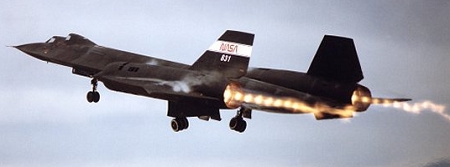Related Resources: calculators
Shock Mach Diamond Formulas and Calculator
Fluids Flow Design and Engineering
Shock Mach Diamond Calculator and Equations
Shock diamonds (also known as Mach diamonds or thrust diamonds) are a formation of standing wave patterns that appear in the supersonic exhaust plume of an aerospace propulsion system, such as a supersonic jet engine, rocket, ramjet, or scramjet, when it is operated in an atmosphere. The "diamonds" are actually a complex flow field made visible by abrupt changes in local density and pressure as the exhaust passes through a series of standing shock waves and expansion fans. Mach diamonds are named after Ernst Mach, the physicist who first described them.
Shock diamonds form when the supersonic exhaust from a propelling nozzle is slightly over-expanded, meaning that the static pressure of the gases exiting the nozzle is less than the ambient air pressure. The higher ambient pressure compresses the flow, and since the resulting pressure increase in the exhaust gas stream is adiabatic, a reduction in velocity causes its static temperature to be substantially increased. The exhaust is generally over-expanded at low altitudes, where air pressure is higher.
As the flow exits the nozzle, ambient air pressure will compress the flow. The external compression is caused by oblique shock waves inclined at an angle to the flow. The compressed flow is alternately expanded by Prandtl-Meyer expansion fans, and each "diamond" is formed by the pairing of an oblique shock with an expansion fan. When the compressed flow becomes parallel to the center line, a shock wave perpendicular to the flow forms, called a normal shock wave or Mach disk. This locates the first shock diamond, and the space between it and the nozzle is called the "zone of silence".The distance from the nozzle to the first shock diamond can be approximated by
Where
x = diamond distance,
D0 = nozzle diameter,
P0 = flow pressure,
P1 = atmospheric pressure

Turbine Exhaust Shock Diamonds
Reference:
- Michael L. Norman; Karl-Heinz A. Winkler (July 1985). "Supersonic Jets". Los Alamos Science
- Scott, Jeff (17 April 2005). "Shock Diamonds and Mach Disks".
- Niessen, Wilfried M. A. (1999). Liquid chromatography-mass spectrometry. Vol. 79. CRC Press. p. 84.
- "Exhaust Gases' Diamond Pattern". Florida International University. 12 March 2004.
Open: Gas Turbine Performance Characteristics
Related:
- NACA Airfoil Plotter and Equations
- de Laval Nozzle Exhaust Gas Velocity Equations and Calculator
- Pitot-Static Tube Velocity of Fluid Flow Measurement Calculator and Equation
- Estimating UAV Drone Propeller Thrust Equations and Calculator
- Aerospace, Aviation Metals Review
- Aviation Maintenance (FAA-H-8083-30A) Technician Handbook General
- Aviation Maintenance Technician Handbook Airframe (FAA-H-8083-31A) Volume 1
- Aviation Maintenance Technician Handbook Powerplant Volume 1
- Aviation Maintenance Technician Handbook Powerplant (FAA-H-8083-32A) Volume 2
- Aviation Maintenance Technician Handbook Airframe (FAA-H-8083-31A) Volume 2